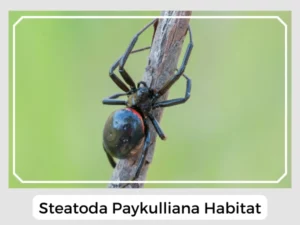Meet the Steatoda paykulliana spider! It belongs to the comb-footed spiders family. Fun fact: it was named after a famous explorer from Sweden, Gustaf von Paykull. Stick around, and we’ll share more about this interesting spider with you!
These spiders spin a cocoon around the eggs to protect them.
The spiderlings hatch at the end of summer. When winter comes, they hibernate.
Female spiderlings have ivory-yellow stripes, which become darker as they become adults.
They spin tangled three-dimensional webs, usually on the sloping ground covered with vegetation.
Yes, Steatoda paykulliana Spiders are venomous. They use their venom mainly to catch and eat their prey. Their venom is less dangerous than true black widows.
Yes, Steatoda paykulliana Spiders can bite. They might bite if they feel trapped or threatened, but they usually keep to themselves and focus on their web and catching food.
This species plays a crucial role in controlling insect populations. They are adept hunters, using their venom to subdue prey such as crickets, cockroaches, and even other spiders, contributing to the balance of their natural habitats.
Natural Predators: The Steatoda paykulliana’s predators include other spider species, which help to regulate their populations and maintain ecological balance within their communities.
Prey-Predator Dynamics: The dynamic between Steatoda paykulliana and their prey is an important aspect of their contribution to the ecosystem. They keep insect populations in check, while also serving as prey to larger predators.
Relationship with Humans: While Steatoda paykulliana is venomous, its bites are not commonly dangerous to humans and are usually less severe than those of true black widows. They tend to avoid human interaction and will only bite if feeling threatened or trapped.
| Lifespan | 1-3 years |
| Distribution | Throughout Asia, Europe, and the Middle East. This includes Albania, Algeria, Austria, Azerbaijan, Belgium, Bosnia, Bulgaria, Corsica, Croatia, Cyprus, Dagestan, Egypt, Eritrea, Ethiopia, France, Georgia, Great Britain, Greece, Herzegovina, Iran, Israel, Italy, Kazakhstan, Lebanon, Libya, Malta, Morocco, Northwest China, North Macedonia, Palestine, Portugal, Romania, Russia, Saudi Arabia, Serbia, Slovenia, Southern Kyrgyzstan, Spain, Switzerland, Syria, Tajikistan, Turkey, Turkmenistan, Tunisia, Ukraine, Uzbekistan, and Yemen. |
| Habitat | Dry or semi-dry habitats, like calcareous hills and quarries, dunes, heathlands, and rock crevices |
| Common Predators | Other spiders |
| Diet | Insects like crickets, cockroaches, ladybirds, woodlice, and spiders, including true black widows |

In summary, Steatoda paykulliana spiders, with their extensive distribution and dietary habits, serve as important biological control agents across diverse habitats.
Meet the Steatoda paykulliana spider! It belongs to the comb-footed spiders family. Fun fact: it was named after a famous explorer from Sweden, Gustaf von Paykull. Stick around, and we’ll share more about this interesting spider with you!
These spiders spin a cocoon around the eggs to protect them.
The spiderlings hatch at the end of summer. When winter comes, they hibernate.
Female spiderlings have ivory-yellow stripes, which become darker as they become adults.
They spin tangled three-dimensional webs, usually on the sloping ground covered with vegetation.
Yes, Steatoda paykulliana Spiders are venomous. They use their venom mainly to catch and eat their prey. Their venom is less dangerous than true black widows.
Yes, Steatoda paykulliana Spiders can bite. They might bite if they feel trapped or threatened, but they usually keep to themselves and focus on their web and catching food.
This species plays a crucial role in controlling insect populations. They are adept hunters, using their venom to subdue prey such as crickets, cockroaches, and even other spiders, contributing to the balance of their natural habitats.
Natural Predators: The Steatoda paykulliana’s predators include other spider species, which help to regulate their populations and maintain ecological balance within their communities.
Prey-Predator Dynamics: The dynamic between Steatoda paykulliana and their prey is an important aspect of their contribution to the ecosystem. They keep insect populations in check, while also serving as prey to larger predators.
Relationship with Humans: While Steatoda paykulliana is venomous, its bites are not commonly dangerous to humans and are usually less severe than those of true black widows. They tend to avoid human interaction and will only bite if feeling threatened or trapped.
| Lifespan | 1-3 years |
| Distribution | Throughout Asia, Europe, and the Middle East. This includes Albania, Algeria, Austria, Azerbaijan, Belgium, Bosnia, Bulgaria, Corsica, Croatia, Cyprus, Dagestan, Egypt, Eritrea, Ethiopia, France, Georgia, Great Britain, Greece, Herzegovina, Iran, Israel, Italy, Kazakhstan, Lebanon, Libya, Malta, Morocco, Northwest China, North Macedonia, Palestine, Portugal, Romania, Russia, Saudi Arabia, Serbia, Slovenia, Southern Kyrgyzstan, Spain, Switzerland, Syria, Tajikistan, Turkey, Turkmenistan, Tunisia, Ukraine, Uzbekistan, and Yemen. |
| Habitat | Dry or semi-dry habitats, like calcareous hills and quarries, dunes, heathlands, and rock crevices |
| Common Predators | Other spiders |
| Diet | Insects like crickets, cockroaches, ladybirds, woodlice, and spiders, including true black widows |

In summary, Steatoda paykulliana spiders, with their extensive distribution and dietary habits, serve as important biological control agents across diverse habitats.